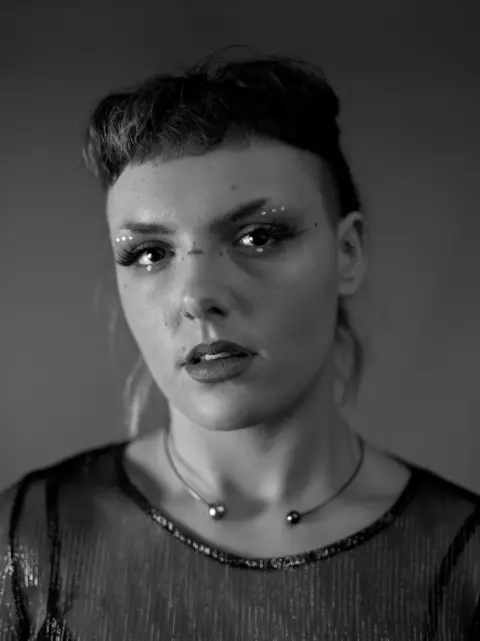Dreamlike Wales inspires Egyptian photographer
 Mohamed Hassan
Mohamed HassanWhen Mohamed Hassan arrived in Wales 15 years ago he spoke very little English and worked in a series of low paid jobs where he endured racism.
Today he is an established documentary photographer with his latest exhibition on show at the Welsh Parliament.
He credits Wales' landscapes with inspiring his creativity and helping him move out of his depression after arriving in the country.
"Taking pictures helped me to stay calm," he said.
"I was nervous, I felt like I wanted to go back because everything was strange around me... but it was so beautiful, I felt like I was dreaming.
"I've never seen the sky so blue or that much green, because in Egypt it's very dusty, very noisy and just different."
 Ahmed Taha
Ahmed TahaMohamed was born in Egypt's second largest city Alexandria, where he gained a degree in oil and gas engineering before meeting his wife, who is half Welsh, at work.
The couple decided to move initially to Laugharne in Carmarthenshire to be near her mother, before moving again to nearby Milford Haven in Pembrokeshire.
"I was working in McDonald's, working in Lidl, but I was always interested in art and taking photographs," said Mohamed.
During this time he had "a lot of problems" when working with customers and on a number of occasions people used racial slurs against him.
 Mohamed Hassan
Mohamed Hassan"I experienced a lot of racism in the beginning and that's why my English never got better, because I was too scared to talk to people," he said.
"I had really bad social anxiety so that's why I started photographing landscapes and people. I was just happy to walk for miles, I just feel better when I'm doing work."
Initially Mohamed used his smartphone to take photos.
People would tell him he had a good eye which encouraged him to start a weekly photography class at Pembrokeshire College.
 Mohamed Hassan
Mohamed Hassan"I bought my first camera and six months later I had a small exhibition in a small gallery in Milford Haven," he said.
In 2014 he went to Carmarthen School of Art to study photography.
"Since that time I haven't stopped making work," he said.
It was a serendipitous meeting with David Hurn, a man often described as Wales' most acclaimed living photographer, that really inspired his work.
 Mohamed Hassan
Mohamed HassanOver the past seven decades, Hurn, who is now 90, has documented everything from the Aberfan disaster to the Beatles at the height of Beatlemania and in the '70s set up Newport's prestigious School of Documentary Photography, producing scores of photographers.
"I told him I was a big fan and he asked me where I was from and what kind of pictures I was doing," said Mohamed.
"He was so nice and inspired me so much as something clicked - on the same day I switched my camera to black and white and learnt new skills."
 Mohamed Hassan
Mohamed HassanMohamed started buying Hurn's photography books and decided to take more of his own photos around Wales.
"I started going to north Wales quite a lot and you'd get in the car and it would be raining or misty, so I start making work by taking pictures from inside the car, like behind the window screen so you get like a dreamy look," he said.
He was also inspired by David Company's book The Open Road: Photography & The American Road Trip.
"I thought maybe I could do that in Wales, get in the car and just take the pictures and let the pictures lead me to the next picture, so more like a narrative or more poetic."
 Mohamed Hassan
Mohamed HassanTaking portraits did not come as easy.
"I was really terrified to take pictures of people because I didn't have the confidence, the language as well was quite hard," said Mohamed.
His tutor encouraged him to persevere.
He found he was naturally attracted to other people who had recently arrived in Wales or were underrepresented in terms of their cultural heritage or class.
He puts this down to his early experiences living in Wales.
"Older people would ask me questions like 'What made you come here? What are you doing here?' It just feels like too many questions, and I used to answer all these questions but now I refuse," he said.
"Maybe that's why I take pictures of people who are similar to me or don't have much of a voice."
 Mohamed Hassan
Mohamed HassanHe said his career began to take off after he emailed about 15 galleries in Wales with examples of his photographs.
"Within a week or two weeks I had six exhibitions," he said.
Last year he was commissioned by the Government Art Collection to photograph Welsh celebrations on the day of the coronation of King Charles.
Currently, his Witnessing Wales exhibition, a long-term study of community and nationhood created through a series of journeys across the country, is at the Welsh Parliament's Pierhead Futures Gallery until 2 November.
Next month The Changemakers Project will go on tour around Wales.
For this exhibition he has photographed Welsh leaders from underrepresented groups, including Wales' former first minister Vaughan Gething, and the photos will be shown alongside others taken by the late acclaimed Kenyan photojournalist Mohamed Amin.
 Mohamed Hassan
Mohamed HassanAll the success is not something Mohamed takes lightly.
"Sometimes I say 'how has that happened?' because four years ago I was just doing this as a hobby," he said.
Today he works solely as a photographer, making his money by selling his work and occasionally teaching photography. He is also working on two books.
"I'm not making crazy money but it's something I really enjoy," he said.
"I don't switch off, photography is my thing.
"All this stuff makes me happy."
